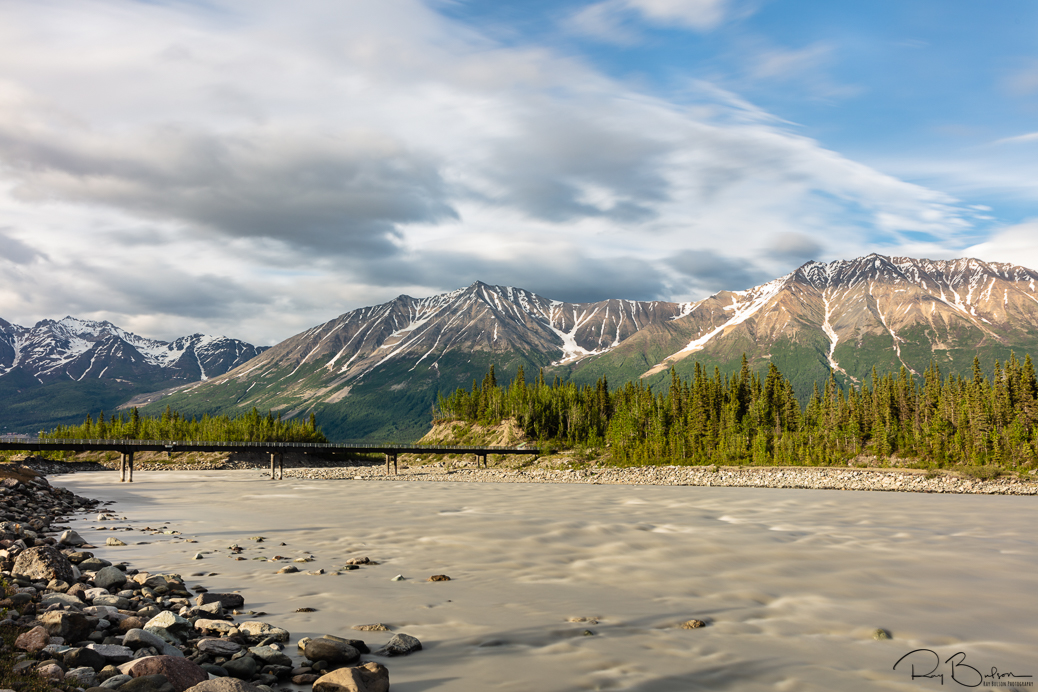
Evening sun on the summer solstice illuminates the Kennicott River, Wrangell Mountains and the foot bridge leading to McCarthy, Alaska. (30 secs. at f/ll and ISO 50)
Long exposure photography involves shutter speeds anywhere from one second to minutes or even hours. These long shutter speeds record the passage of time on a still medium. With moving objects a sense of motion is conveyed. What makes this form of photography so much fun is that it captures imagery that our eyes cannot. Results can be unpredictable and mesmerizing. In astrophotography, shutter speeds of minutes or hours renders stars as trails of light. Several seconds to minutes transforms cascading water into silky smooth veils. Moving clouds stretch out like cotton candy being pulled. Wind blown foliage and grasses become blurred. What was once a hard scenic softens into a more painterly composition.
To achieve long exposure times in daylight requires the use of a neutral density filter. Quite simply, a neutral density (ND) filter is a darkened piece of glass that holds back the light reaching the camera’s sensor requiring a longer shutter speed to achieve a proper exposure. NDs typically come in strengths of 5, 6, 10, and 15 stops. To use NDs a base exposure time is determined without the filter on the lens. Then the filter is put on the lens and the shutter speed is doubled for every stop of filter strength. This is where some people struggle with shutter speeds and the math and end up resorting to trial and error. Below are three easy ways to arrive at the correct long exposure time.
Count the Clicks
This method works for final exposure times less than 30 secs. Make sure you are in manual exposure mode. Choose your composition, focal length, focus point, f/stop, shutter speed and ISO (i.e., exposure) without the filter. Then put on the filter. To get to the correct exposure time, advance the shutter control dial (increase shutter speed) one click if your dial moves in 1-stop exposure increments, two clicks for ½-stop exposure increments, and three clicks for ⅓-stop exposure increments for every stop of filter strength. For example, the base exposure for the photo above without the ND filter was 1/30th of a second. I used a 10-stop ND filter. Because my camera is set to ⅓-stop increments, I advanced the shutter control dial 3 clicks x 10 stops = 30 times to arrive at a final exposure time of 30 seconds. If your camera is set to ½-stop increments then advance the dial 20 clicks. And for 1-stop increments advance the dial 10 clicks. Pretty simple, right? But what if you get to exposure times beyond 30 seconds and into minutes? This is where you would use the next method.
6400 ISO Rule
If the final long exposure time requires minutes then the 6400 ISO rule works well. Without explaining the math, basically the rule is that the exposure time in seconds at ISO 6400 is equivalent to the same time in minutes at ISO 100. There is no need to determine a base exposure without the filter on. Instead you finalize your composition without the filter because it’s too dark to see with it on (just as you would in the previous method). Then you put on the filter and set your ISO to 6400. Like the prior method make sure you are in the manual exposure mode. Increase the shutter speed until the exposure needle is at zero indicating a proper exposure. Then set the ISO to 100 and the exposure mode to B for bulb. The number of seconds for the exposure at ISO 6400 becomes the setting in minutes at ISO 100. For example, an exposure of 6 seconds at ISO 6400 is equivalent to 6 minutes at ISO 100. To take the photo requires a shutter release cable that can be locked down and a timer to count down the minutes. Some new cameras even have a built-in timer for the bulb setting. If this is still too difficult then try the last method which is the easiest of all three.
Use an App
A number of smart phone apps are available to calculate exposure times using ND filters. The easiest is a free app called NiSi Filters provided by the manufacturer of the same name that makes ND filters. It has one screen where you select the normal shutter speed (without the filter on) and then select the strength of the ND filter. It calculates the shutter speed in hr:min:secs with the filter on. It even has a GO button to press that counts down the exposure time for you! Nothing can be simpler than that. PhotoPills and Slower Shutter are other apps that also calculate equivalent exposure times for ND filters. The only downside to this method is that you need to bring your phone with you in the field for it to work!
Long exposure photography lets you render your vision of the outdoors in new and unique ways. Don’t let the anxiety of calculating exposure times stop you from trying it. Use one of these methods instead and unleash your creativity.


